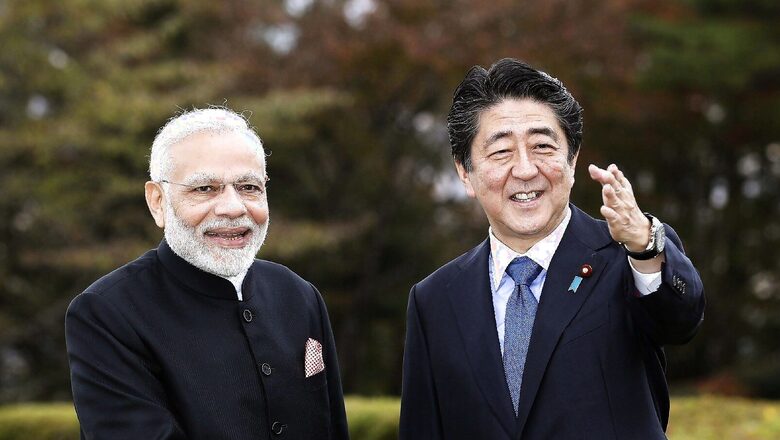
views
Japan is in deep mourning after the assassination of former Japanese Prime Minister and Member of the Lower House of the Diet Shinzo Abe. So is India. The Government of India declared 9 July to be the day of mourning with national flags all over India flying half-mast and with no official entertainment for the day.
This is no symbolic gesture on the part of India. It is heartfelt respect for a lovable foreign leader whose contribution towards promoting India-Japan bilateral ties, peace and stability in the Indo-Pacific region and maintenance of global liberal order was immeasurable during his tenure as the Prime Minister of Japan.
The Indian Prime Minister, several other Cabinet Ministers, and political leaders cutting across party lines in India expressed their deep condolences to the grieving family members of the Abe family. This indicates how much Shinzo Abe was respected, appreciated and admired in India.
A leader with a vision and the ability to shape the vision, Shinzo Abe will always be remembered for his innovative idea and strategic concept of the Indo-Pacific. Significantly, Prime Minister Abe articulated the concept of the Indo-Pacific on the Indian soil during his visit to India about fifteen years ago in his speech to the parliamentarians. His concept of the “Confluence of Two Seas” ultimately took shape as Indo-Pacific, which has become the most meaningful strategic framework to understand developments in the Indian Ocean and the Pacific Ocean.
The reason why Prime Minister Abe unveiled his Indo-Pacific concept in New Delhi is not difficult to discern. He did so, because he could visualise the role of an emerging India in the complex regional order in the first decade of 21st century that was severely affected by the United States getting trapped in the Afghan quagmire and China’s “peaceful rise” theory becoming irrelevant. He understood what Japan and India together with the United States and Australia could do to maintain order, promote stability and achieve prosperity in a region beyond the so-called “Asia-Pacific” and to include the countries of the Indian Ocean region.
When he proposed the “Confluence of Two Seas”, there were not many takers. When he advocated the concept of “Democratic Diamond” consisting of Japan, the United States, India and Australia”, there was little excitement even in the academic circles. Abe was, however, not discouraged and when he became the Prime Minister again in 2012 and continued in the post until he resigned in 2020, he succeeded in taking steps and making remarkable diplomatic moves to realise his vision and as a result the strategic framework of “Indo-Pacific” has today become one of the most widely discussed and debated themes.
It is noteworthy that Abe was the key leader who played a major role in reinvigorating the Quad or Quadrilateral Security Initiative in 2017. There is little doubt that Chinese military muscle flexing and quiet expansionism gave new life to Quad, but Shinzo Abe and other leaders resolved not to make it a military bloc or anti-China bloc.
It is also worth underlining that Shinzo Abe’s determination to alter the Japanese foreign policy and make Tokyo a pro-active player in regional affairs along with India was possible because of the emergence of Narendra Modi as an influential Prime Minister with great vision on India’s domestic renewal and its role as a robust player in world affairs.
The personal chemistry of Modi and Abe matched! Both had dynamic leadership in their respective domestic affairs and both were interested in playing a greater role in international affairs commensurate with their country’s achievements and potentials.
Prime Minister Modi gave new and vigorous impetus to earlier Indian policies on economic growth and foreign engagements. The “Look East” policy of the early 1990s was renamed “Act East Policy” and was actually acted upon giving abundant emphasis to make Japan a partner for progress and prosperity. Abe was aware that success of Quad would not be possible without Indian cooperation, since Japan and Australia were already alliance partners of the United States. Prime Minister Modi showed no hesitation, unlike earlier governments, in joining the Quad.
The Belt and Road Initiative of China involved several predatory economic practices and made the Indo-Pacific countries vulnerable to Chinese blackmail or undue influence. Shinzo Abe proposed the idea of an alternative Asia-Africa Growth Corridor and India promptly joined the initiative.
Both Modi and Abe made their respective countries forceful players in international affairs and joined hands wherever it was due in the Indo-Pacific region. There are many novel developments in world affairs from time to time. One of the most significant developments that has drawn less attention than due is the trajectory of Japan-India relations in the post-Cold War era. Japan has become India’s major source of investment, technology transfer, trade and business, and security cooperation.
The strategic convergence of India and Japan gently grew after the end of the Cold War, but its size, scope, and momentum picked up under the leadership of Shinzo Abe and Prime Minister Narendra Modi. Abe is no more and it is a big loss to even Japan-India relations, but the silver lining in the current dark clouds is the fact that Abe’s successor, current Prime Minister Fumio Kishida, too, has been active in leveraging the legacy of Abe and boosting further bilateral relations with India and coordinating respective approaches in multilateral forums on regional and global issues.
Read all the Latest News, Breaking News, watch Top Videos and Live TV here.



















Comments
0 comment